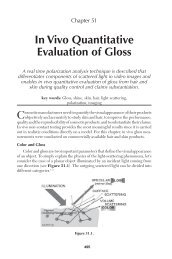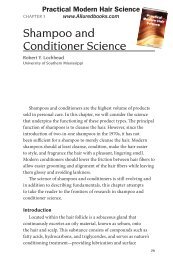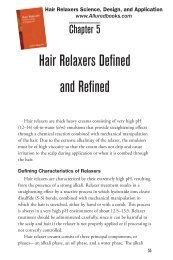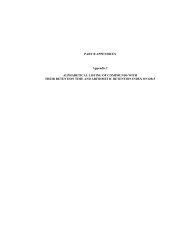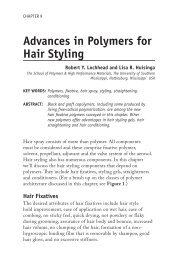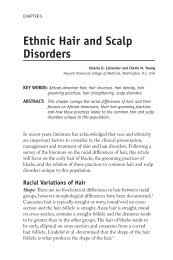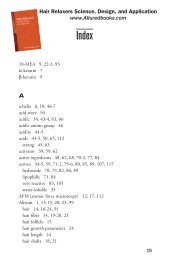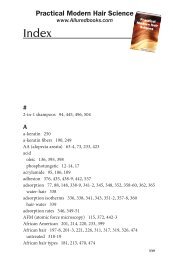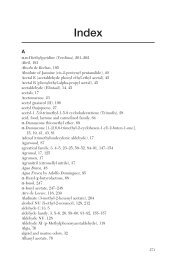A Diester to Protect Hair from Color Fade and ... - Alluredbooks.com
A Diester to Protect Hair from Color Fade and ... - Alluredbooks.com
A Diester to Protect Hair from Color Fade and ... - Alluredbooks.com
You also want an ePaper? Increase the reach of your titles
YUMPU automatically turns print PDFs into web optimized ePapers that Google loves.
420<br />
Chapter 35 Gao et al.<br />
To test the ability of the diester <strong>to</strong> protect hair fibers in rinse-off<br />
systems, a shampoo <strong>and</strong> conditioner were formulated with <strong>and</strong> without<br />
the diester (see Formulas 1 <strong>and</strong> 2).<br />
UV <strong>Protect</strong>ion with <strong>Diester</strong><br />
UVA protection in shampoo: Auburn-colored tresses were treated<br />
with the control <strong>and</strong> diester shampoo <strong>and</strong> exposed <strong>to</strong> 15 equivalent<br />
days of UV exposure (see Figure 35.2). The treated tresses were<br />
visually <strong>com</strong>pared <strong>to</strong> one another <strong>and</strong> <strong>to</strong> a dyed tress that was not<br />
exposed <strong>to</strong> UV irradiation (Figure 35.2a). The tresses treated with<br />
the control shampoo (Figure 35.2b-c) lost a significant amount of<br />
color while the hair tresses washed with the shampoo containing the<br />
diester (Figure 35.2d-e) showed less color fade. The <strong>to</strong>tal color loss<br />
(∆E) of the tresses treated with the shampoos was also assessed after<br />
15 days of UV exposure. Tresses that demonstrated better color protection<br />
had a smaller ∆E. The quantitative color loss data confirms<br />
what the visual assessment illustrates—that the shampoo containing<br />
the diester had a significantly smaller ∆E, <strong>and</strong> the diester-treated<br />
tress maintained more color. The diester thus demonstrates color<br />
protection with a ∆E of 10.5, <strong>com</strong>pared <strong>to</strong> the control shampoo<br />
with a ∆E of 12.4, a difference of almost 2 units (see Figure 35.3).<br />
To confirm the correlation between visual inspection of images,<br />
color index measurement <strong>and</strong> consumer perception, 17 panelists<br />
selected the tresses they thought had the most <strong>and</strong> least change in<br />
color after tresses were exposed <strong>to</strong> 15 days of UV. Subjective evaluation<br />
results indicated that 100% of the panelists perceived that<br />
the diester shampoo gave superior color protection on the medium<br />
auburn treated hair (data not shown).<br />
A similar study was performed with the shampoos on hair dyed<br />
with medium brown color. The tresses shown in Figure 35.4 were<br />
treated with the control <strong>and</strong> diester shampoo. <strong>Hair</strong> tresses washed<br />
with the diester shampoo (Figure 35.4e-f) showed less color fade<br />
than the control shampoo (Figure 35.4c-d). The left two tresses<br />
were dyed <strong>and</strong> not exposed <strong>to</strong> UV (Figure 35.4a-b), <strong>to</strong> serve as a<br />
reference.<br />
Figure 35.5 shows the quantitative ∆E <strong>to</strong>tal color changes of<br />
hair tresses colored medium brown that were treated with both<br />
shampoos <strong>and</strong> exposed <strong>to</strong> 15 days of UV exposure. <strong>Hair</strong> tresses



